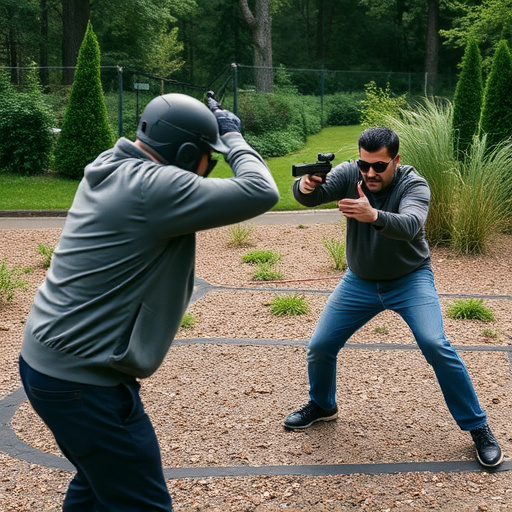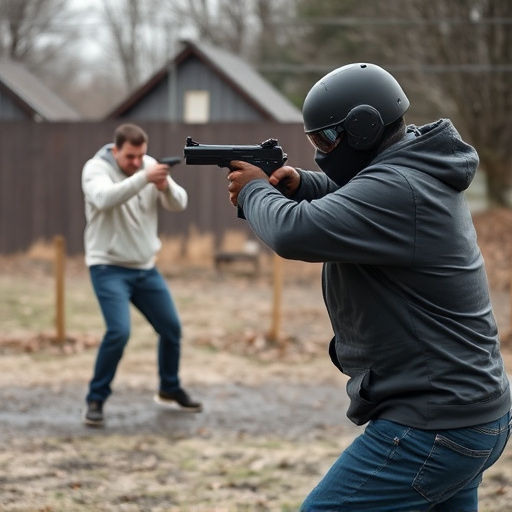Stun guns rely on proper charging (following manufacturer guidelines), storage (cool, dry conditions), and maintenance (regular testing, avoiding overcharging) to prevent misfires and ensure reliability. With intelligent charging systems, safety switches, and clear user manuals, stun guns offer enhanced safety features for responsible use in critical situations.
Stun guns, designed as non-lethal self-defense tools, rely on precise electrical current delivery to incapacitate assailants. However, understanding their mechanics is key to preventing misfires. This article delves into the intricacies of stun gun functionality, exploring common issues and vital pre-use checks. We highlight essential steps like proper charging techniques, crucial for ensuring full functionality. Additionally, we examine environmental factors and advanced safety features engineered to avert misfires, offering a comprehensive guide to optimal stun gun performance. Learn how to charge your stun gun properly and navigate potential pitfalls.
- Understanding Stun Gun Mechanics: How They Work and Common Misfires
- Essential Pre-Use Checks: Preparing Your Stun Gun Before Deployment
- Proper Charging Techniques: Ensuring Your Stun Gun is Fully Functional
- Avoiding Environmental Factors: Storage and Conditions that Affect Performance
- Safety Features Designed to Prevent Misfires: A Look at Advanced Technologies
Understanding Stun Gun Mechanics: How They Work and Common Misfires

Stun guns, also known as electric stun devices, operate by delivering an electric current through two metal probes or electrodes to disrupt muscle control in the target’s body, causing temporary incapacitation. Understanding how they work involves grasping the fundamentals of their mechanical design and electrical components.
Common misfires often occur due to improper usage or maintenance. For instance, a stun gun might not fire as expected if it hasn’t been charged correctly—a crucial step in ensuring its functionality. The charging process involves connecting the device to a power source, following manufacturer guidelines for the correct voltage and duration. Other potential causes of misfires include faulty batteries, damaged electrodes, or improper handholding during activation.
Essential Pre-Use Checks: Preparing Your Stun Gun Before Deployment

Before deploying your stun gun, conducting thorough pre-use checks is paramount to ensuring its reliability and safety. One of the critical aspects is verifying the device’s power source – ensuring it’s fully charged. Stun guns rely on high-voltage batteries, so a simple check of the charge level can prevent accidental discharge due to a dead battery. Most modern stun guns come with LED indicators that show when they’re powered up and ready for use.
Proper charging is just as important as regular maintenance checks. Always follow the manufacturer’s guidelines on how to charge your stun gun correctly, usually through a USB cable. This simple step ensures optimal performance, prevents misfires, and prolongs the device’s lifespan. Regularly testing the stun gun after each recharge also helps keep you familiar with its operation, further minimizing the risk of unexpected malfunctions.
Proper Charging Techniques: Ensuring Your Stun Gun is Fully Functional

Proper charging techniques are essential for ensuring your stun gun is fully functional and ready when you need it. To charge your stun gun correctly, start by removing any protective casing or covers to access the charging port. Use only the charger provided with your device and follow the manufacturer’s instructions precisely. Incorrect charging can lead to damage, reduced performance, or even misfire.
Avoid overcharging by removing the charger once the battery is fully charged, typically indicated by a light turning off or a specific notification on the device. Always store your stun gun in a dry, cool place and keep it out of reach of children or unauthorized individuals. Regularly check the charging status to ensure optimal performance and be prepared for any unexpected situations.
Avoiding Environmental Factors: Storage and Conditions that Affect Performance

Proper storage and ideal conditions are crucial to ensuring your stun gun functions optimally. Environmental factors can significantly impact performance, so it’s essential to understand what to avoid. Extreme temperatures, both hot and cold, can damage the device. Keep your stun gun in a temperature-controlled environment, typically between 50°F to 85°F (10°C to 29°C), to maintain its integrity. Moisture is another enemy; never store or use a stun gun in humid conditions as it can lead to corrosion and malfunctions.
When charging your stun gun, follow the manufacturer’s guidelines meticulously. Insufficient charging can result in a misfire due to a drained battery. Regularly check the device’s power level and ensure it stays fully charged. Additionally, avoid exposing the stun gun to direct sunlight or leave it in a hot car, as these actions can accelerate battery degradation and affect overall performance.
Safety Features Designed to Prevent Misfires: A Look at Advanced Technologies

Stun guns, like any high-voltage device, require careful handling and proper maintenance to ensure safety. Advanced technologies have been incorporated into modern stun guns to prevent misfires and accidental discharge, making them safer for both users and bystanders. One key feature is the inclusion of intelligent charging systems that not only maintain optimal battery performance but also monitor the device’s internal components to detect any anomalies that could lead to misfire. These systems use advanced algorithms to regulate voltage levels, ensuring the stun gun operates within safe parameters.
Additionally, many modern stun guns come equipped with safety switches and multiple activation triggers, which require deliberate and conscious action to deploy. This prevents accidental activation, a common concern with less sophisticated models. Proper user manuals that detail how to charge a stun gun correctly, store it safely, and handle it responsibly are also vital components of misfire prevention. Users who follow these guidelines can significantly reduce the risk of accidents and ensure the device remains reliable in critical situations.
Stun guns, when used correctly, can be powerful tools for self-defense. By understanding their mechanics, performing essential pre-use checks, and following proper charging techniques, users can ensure optimal performance. Environmental factors and advanced safety features designed to prevent misfires further enhance their reliability. Remember, the key to safe and effective deployment lies in preparation and understanding the technology. Always follow manufacturer guidelines, especially when it comes to how to charge a stun gun properly, to ensure your device is ready when you need it most.
